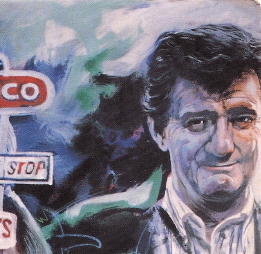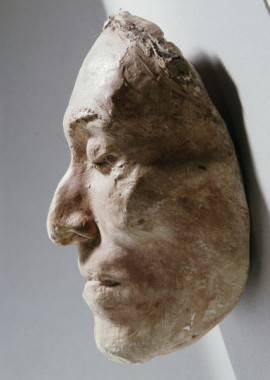 Gerald VIZENOR—"ISHI OBSCURA" [from Manifest Manners (1994)]—Outline/Handout Gerald VIZENOR—"ISHI OBSCURA" [from Manifest Manners (1994)]—Outline/Handout  | ||
|---|---|---|
| —All par. cit. p. #'s refer to our PDF version (the original essay, in Manifest Manners), unless "SD" is included: these par. cits. refer to a later version of the essay, in his Shadow Distance (a "Greatest Hits") collection. | ||
• Introductory Note: As someone imbued in French theory, Vizenor is comfortable with (or notorious for!) coining his own words, and I should explain a few that are central to his theoretical writings, including the "Ishi" essay: | ||
| ** manifest manners (e.g., 127): (playing on "Manifest Destiny,") this is Vizenor's term for the general racial discourse of Euro-American colonialism (including literature), especially as it regards Native Americans: e.g., Indians are primitive, heathenish, lazy, drunk, et al. In fact, it's easily understood as the American indigenous version of Said's Orientalism (and indeed, both stem directly from Foucault's discourses of power). | ||
| ** survivance (e.g., 127): (playing on Native "survival"—plus "resistance,") this is contemporary "survival" as practiced by Natives via words, stories, literature. As in Momaday and other Native American writers, there is an emphasis on the heard, not the written (as in the "oral tradition"). (One might perceive in this, at last, rather a reprivileging of Derrida's phonocentrism?) Thus Ishi's acts of insurrection (if you will) against his captors include telling his stories so quickly that they can't be written down. (And also a trickster silence, especially regarding his real name.) To recast the postcolonial buzz-phrase, "survivance" is not so much "writing back against the Empire" as it is "speaking back," or not speaking at all. (However, for Native writers like Momaday and Vizenor, "survivance" has usually been more an attempt to continue the "oral tradition" in written texts. Ironically, and of course.) | ||
• Introductory Note #2: the title "Ishi Obscura" is an allusion to the old optical device called the "camera obscura," and also, by extension, Roland Barthes' famous postmodernist text, Camera Lucida (1980), in which Barthes claims the photograph to be a "flat death," an inevitable "this has been." . . . And so Ishi's photos = a dead finality that "is the absence of stories" (129) . . . Vizenor (as if to hide to Barthes influence?!) discusses Sontag on photography instead, as "simulation," predation, violation, reification, and "absence"—vs. the "heard" of "tribal stories" (129-130). . . . Then there are the old photos of chiefs—"captured as proud warriors . . . overhea[r]d as simulations too much," and "translated without [natural] reason*" (134-135). (More on Ishi & photography to follow.) | ||
| *: "natural reason" (see also 126) is another coined Vizenor phrase, which means very much the opposite of the Western reason of linearity & logic, and is more an intuitive & experiential way of knowing—at last, a more "Native" relationship with the environment and the "seasons." | ||
• 1st sentence: "Ishi was never his real name" (126). This pretty much sums up the essay?! Note that "Ishi" simply means "'one of the people'" (128); "'His [personal] name, if he knows it, he keeps to himself'" (132); and his identity, then, is (un-)revealed as a facade of false namings & representations & projections (& photos) | ||
• 2nd sentence: "Ishi is a simulation, the absence of his tribal names" (126). While meaning practically the same thing as "Ishi was never his real name," Vizenor demonstrates his allegiance to French poststructuralism here: "simulation" is an obvious debt to Baudrillard's simulacra (signifers for which there are no real referents); and "absence" is indebted to Derrida, for whom "presence/absence" is a central binary, and who ultimately privileges absence as the better description of discourse in general—especially written discourse. | ||
 | ||
• To clarify what Ishi was not: "Ishi is not the last man of stone. He is not the obscure other, the mortal silence of savagism* and the vanishing race. . . . the silence of that tribal man is not the dead voice of racial photographs and the vanishing pose" (126). . . . A newspaper article of the day proclaims, "'The man is as aboriginal in his mode of life as though he inhabited the heart of an African jungle, all of his methods are those of primitive peoples" (128; oh, "heart of darkness"! Oh, Said!). | ||
| —* "Savagism" references one of the early influential works of American Studies, Roy Harvey Pearce's Savagism and Civilization (1953). Pearce's notion of "savagism" as a Western construct projected by a "self-affirming" civilized self (see Said) no doubt influenced Vizenor's own "manifest manners." | ||
• Ishi & the Anthropologists: described as the "romantic heirs" of the white miners who captured Ishi, the anthropologists studying Ishi are perhaps as interesting to Vizenor as Ishi himself. They are "witnesses at the simulation of savagism"—i.e., Ishi—who "could become the last epiphanies of a chemical civilization" (127; this latter will become clearer!). | ||
| —The anthropologists are above all characterized as nostalgic closet-Romantics seeking elsewhere for some salvation for/from a civilization they perceive to have gone awry. (This pretty much sums up the poet John G. Neihardt, too, BTW.) For instance, Alfred Kroeber dubs Ishi "the last wild Indian in the United States" (SD 188); and again: Ishi "brought with him much primeval and tribal lore of the most ancient of arts which will be prove as romantic . . . as it is fascinating" (SD 188)—a good example of "manifest manners" at work. (Of course, "manifest manners" includes not only the romanticization of the "Noble Savage," but the certainty that the "Savage" will inevitably soon "vanish," become extinct. So the LAST Yana Indian is especially "fascinating.") | ||
 | —Vizenor evinces some sympathy (or pity) for these (fellow!) academics; but such "college men . . . were the same men who discovered and then invented an outsider"; They were not insensitive, to be sure, "but their studies and museums would contribute to the simulations of savagism" (131)—just as, a century earlier, learnèd Orientalists contributed to another large-scale racial othering. Vizenor even performs some culture psychoanalysis on them: "some of these educated men were liberal nihilists[!], and their academic strategies dispraised civilization" (131-132). [Again, like John G. Neihardt.]. "These men who represented civilization would find in the other what they had not been able to find in themselves or their institutions[!]; the simulations of the other became the antiselves [that is, the projected 'Other'] of their [bourgeois] melancholy" (132; see also the Wanamaker enterprise [133-136]). This loaded sentence says a lot of things: first of all and once again, it's usually never about the Other, but a Self in need of affirmation, recuperation; at this historical-cultural-colonial moment, Western academics were prone to find solace/escape from what they perceived to be their own pretty botched culture by USING the Other as part of some nostalgia for Romantic origins & purity? | |
| —Also note that the whole let's-take-pictures-of-Injuns craze was a cultural act of myth-as-history-making: it was, after all, "a nation eager to create a tragic history of the past" (136). | ||
| —But we are then left with the cultural irony of Ishi, who "lived and worked in a museum" for the rest of his life (135), the antiself of a "lonesome and melancholy civilization" (137). | ||
• Vizenor's Style is characterized by long, verbose (yet somehow still lyrical!?) sentences that "namedrop" two or three of his coined words, leaving the reader in a semi-impressed semi-daze. E.g.: "Ishi came out of the mountains and was invited to a cultural striptease at the centerfold of manifest manners and the histories of dominance; he crossed the scratch line of savagism and civilization with one name, and outlived the photographers. His survivance, that sense of mediation in tribal stories, is heard in a word that means 'one of the people,' and that word became his name. So much the better, and he never told the anthropologists, reporters, and curious practitioners his sacred tribal name, not even his nicknames" (127-128). | ||
| —Note that "histories of dominance" is pretty much a decent re-definition of "manifest manners." Also characteristic is that this sentence is rather another stand-alone recap of the essay, like "Ishi was never his real name." Ishi's life was a confrontation of white-colonial "manifest manners" vs. his own Native "survivance," which is (best) "heard," not written—or if necessary, suffered in silence. | ||
| —Another characteristic of Vizenor's style is its non-linearity. He often repeats the same point later (kind of like this outline), as if looping back in time; and he just as often begins a new paragraph completely disjunctively, "out of the blue"—'cuz a cool quote from Foucault just tickled his fancy?!—as if the logic of linearity meant nothing. It's easy—and it's been done—to deem this a particularly "Native" style, of timeless circularity!? But I balk at such essentialism! (However, to be honest, this is one of Vizenor's more "linear" and orderly essays.) | ||
• Ishi (& Vizenor) as the Trickster: Ishi's "Trickster hermeneutics is the silence of his nicknames" (128). "Hermeneutics" can be read here, roughly, as "interpretation," as in a trickster approach to reality, and especially as a response to "manifest manners." (Later, Ishi's "poses" are described as revealing a "lonesome humor" [133].) Ishi's "survivance" includes this "trickster" play with his captors and dominant ideologies (e.g., 135). Vizenor likewise describes himself elsewhere as being a "crossblood [mixed-blood] trickster" in his writing—which explains in part his "perplexing" style (though his Euro-postmodern influences probably have as much to do with it!). | ||
| —And yet Vizenor also makes clear that Ishi becomes somewhat assimilated: isn't that Vizenor's point in relating the fact that, later, Ishi would never take his white-man overalls off anymore (132)? And the whole comedy of his expertise regarding photography (133)?! | ||
• (More on) Ishi & "Survivance": "survivance" is based on tribal orality; it is the "sense of mediation in tribal stories" (127-128); it is "the presence of imagination, oral stories, the humor in trickster stories, and the observation of actual behavior and experience [natural reason]" (128). Also: "To be heard was once a course of survivance in tribal imagination"; but with colonization, "the sounds of the stories, the human touch of humor and silence, and visions must be" replaced with photographs, and written textuality, etc. (129). Later, Ishi is "a winsome[!] warrior of survivance, not a religious leader or a warrior chief. . . . His personal power was more [trickster-]elusive than the political poses of a tribal leader. . . . His stories were his survivance" (134). Vizenor earnestly contrasts Ishi's behavior with the "simulated" tribal leaders: Ishi's "power is more communal than personal, and the power of the spoken word goes with the stories of the survivors, and becomes the literature of survivance" (135). But his "stories" were mostly silence, en'it?!—above all, Ishi "should be honored for more than his stories, his humor, and survivance; he should be honored because he never learned how to slow his stories down to be written and recorded" (136). . . . But at last (to end on a downer), silence has its drawbacks: in spite of the fame of his (simulated) name, "he has seldom been heard as a real person" (137). | ||
• (More on) "Manifest Manners": Vizenor fills out the attributes of "manifest manners": it includes not only primitivism, but "racialism and postmodern speciesism[!], a linear consideration that was based on the absence of monotheism, material evidence of civilization, institutional violence, and written words" (128; i.e., these were used as evident for racism, and against Ishi's humanity); the result is an "absence," not a "presence" (128; in contrast, Vizenor considers Native "survivance" as a positive, and indeed phonocentric, presence.) | ||
• Ishi & Photography (see also "Introductory Note #2," above): Vizenor's citations from Sontag feel like metonyms for the ideas of Barthes and Baudrillard as critiques of photography and simulation: "The absence of the tribes is sealed, not real, in a photograph; the absence is a simulation" (129); "The simulation [of the photograph] supercedes the real and remembrance" (130). Photos of Ishi, in particular, are "the simulations of a vanishing pose*" (133; w/ echoes of the "vanishing Indian"). Then there is that most uncanny anecdote about the the "simulated tattoo" on Ishi in one of the Wanamaker photos, which "enhances the image of a naked savage" (134)! (I'm still not sure what to make of this, including Vizenor's point.) . . . And finally, it is largely because they were photographed that the chiefs, "tribal leaders," became mere "simulated leaders": "Some tribal leaders were captured as proud warriors in photographs; they were heard . . . as simulations too much, and translated without reason, and out of season; their stories were lost to manifest manners, and lost at inaugurations and in wild west shows" (134-135). | ||
| —* The full sentence is poignant: "You were not the last memories of the tribes, but you were the last to land in a museum as the simulations of a vanishing pose in photographs." | ||
• Coda: Karl Kroeber: you have to relish the famed anthropologist's final act of conscience(?), his "tribute" upon Ishi's death?: don't give up his body to anthropology!, he says—"If there is any talk about the interests of science, say for me that science can go to hell"! But his following words are sadder: "We have hundreds of Indian skeletons that nobody ever comes near to study[!!]. The prime interest in this case would be of a morbid romantic[!!] nature" (137). (Ooh.) | ||
• ISHI's DEATH MASK::::  | ||
Vizenor, Gerald. "Ishi Obscura." Manifest Manners: Narratives on Postindian Survivance, U of Nebraska P, 1994, pp. 126-137. | ||
---. "Ishi Obscura." Shadow Distance: A Gerald Vizenor Reader, Wesleyan UP, 1994, pp. 184-193. | ||
| —TCG, July 2016; October 2020 | ||